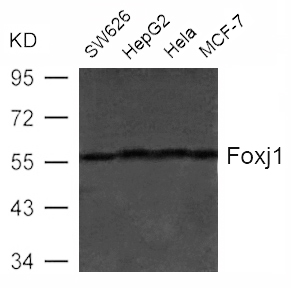
| WB | 咨询技术 | Human,Mouse,Rat |
| IF | 咨询技术 | Human,Mouse,Rat |
| IHC | 1/50-1/200 | Human,Mouse,Rat |
| ICC | 1/100-1/200 | Human,Mouse,Rat |
| FCM | 咨询技术 | Human,Mouse,Rat |
| Elisa | 咨询技术 | Human,Mouse,Rat |
| Aliases | HFH4; HFH-4; FKHL13 |
| Entrez GeneID | 2302; |
| WB Predicted band size | 58kDa |
| Host/Isotype | Rabbit IgG |
| Antibody Type | Primary antibody |
| Storage | Store at 4°C short term. Aliquot and store at -20°C long term. Avoid freeze/thaw cycles. |
| Species Reactivity | Human,Mouse,Rat |
| Immunogen | Peptide sequence around aa.413~417( D-W-A-S-V) derived from Human Foxj1 (HFH4). |
| Formulation | Purified antibody in PBS with 0.05% sodium azide. |
+ +
以下是关于Foxj1(HFH4)抗体的3-4篇参考文献的简要概括:
1. **文献名称**:*Foxj1 is required for apical localization of ezrin in airway epithelial cells*
**作者**:Chen et al. (2007)
**摘要**:研究通过免疫染色和Western blot分析,使用Foxj1抗体揭示了Foxj1在调控肺上皮细胞顶膜极性蛋白ezrin定位中的作用,表明Foxj1缺陷导致纤毛结构异常。
2. **文献名称**:*The forkhead protein Foxj1 specifies node-like cilia in left-right asymmetry*
**作者**:You et al. (2004)
**摘要**:通过Foxj1抗体免疫组化实验,作者发现Foxj1在胚胎节点纤毛形成中起关键作用,其缺失导致小鼠左右轴发育缺陷。
3. **文献名称**:*Foxj1 transcription factors are master regulators of the motile ciliogenic program*
**作者**:Brody et al. (1998)
**摘要**:该研究利用Foxj1抗体进行组织特异性表达分析,发现Foxj1直接调控多个纤毛运动相关基因,是纤毛发生的关键转录因子。
4. **文献名称**:*HFH4 is required for postnatal lung epithelial homeostasis and regeneration*
**作者**:Stubbs et al. (2008)
**摘要**:通过Foxj1抗体标记实验,研究证明Foxj1在维持肺上皮细胞纤毛稳态中不可或缺,并参与损伤后的再生修复过程。
这些文献均通过Foxj1抗体探讨了其在纤毛发生、细胞极性及发育疾病中的功能。建议通过PubMed或Google Scholar核对具体引用格式。
The Foxj1 (Forkhead box J1) protein, also known as HFH4 (Hepatocyte Nuclear Factor 3/Forkhead Homolog 4), is a member of the Forkhead family of transcription factors characterized by a conserved winged-helix DNA-binding domain. It plays a critical role in regulating the development and function of ciliated epithelial cells. Foxj1 is specifically expressed in cells with motile cilia, such as those lining the respiratory tract, reproductive organs, and brain ventricles, where it governs ciliogenesis and ciliary motility by activating genes involved in axoneme assembly and dynein motor protein production.
Antibodies targeting Foxj1 are widely used as markers to identify ciliated cell populations in tissues and to study cellular differentiation pathways. They enable researchers to visualize Foxj1 expression via techniques like immunohistochemistry (IHC), immunofluorescence (IF), and Western blotting. These tools have been instrumental in exploring pathologies linked to ciliary dysfunctions, including primary ciliary dyskinesia, chronic respiratory diseases, and hydrocephalus. Additionally, Foxj1 antibodies aid in investigating Foxj1's regulatory interactions in signaling pathways, such as Notch and TGF-β, and its role in maintaining tissue homeostasis. Their specificity and reliability make them essential for advancing studies in developmental biology, pulmonary medicine, and reproductive health.
×